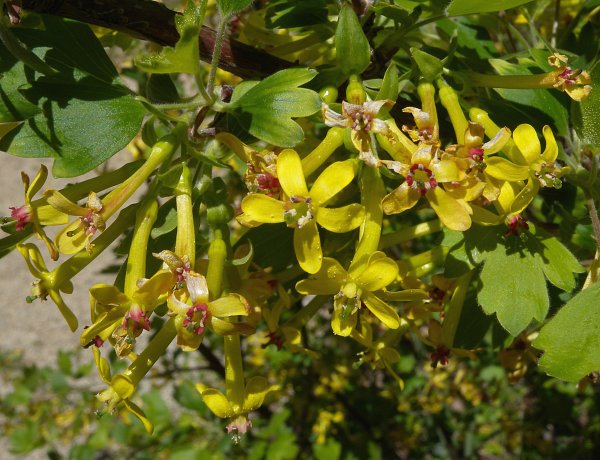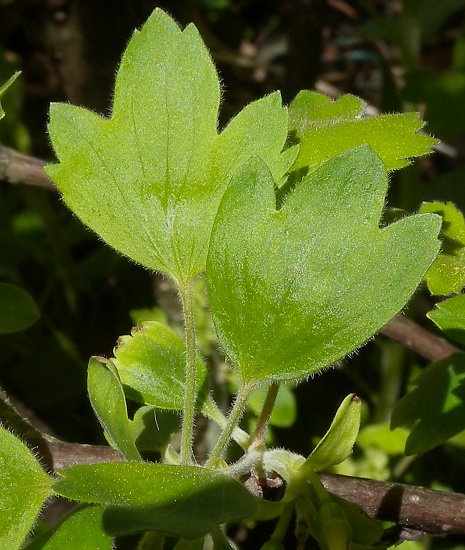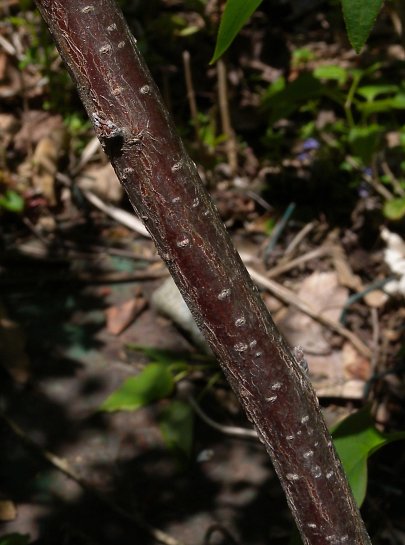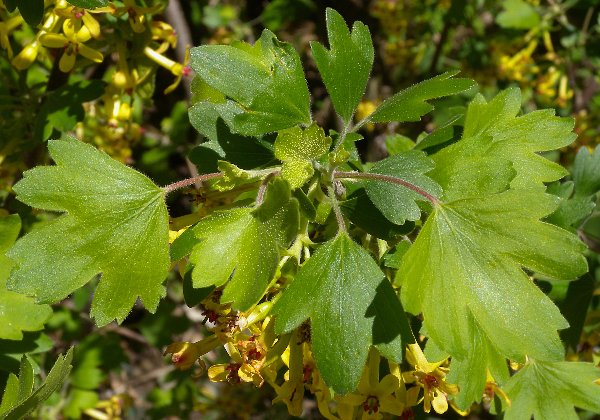
Short racemes of 3-15 flowers develop from the axils of the leaves. These racemes and their flowers have a tendency to arch and droop; the racemes are about 1-3" long. Each flower is about ¾" long and about one-half as much across. The corolla-like sepals are joined to together, forming a narrow tubular structure at the base of the flower and 5 spreading lobes above. The joined sepals are usually bright yellow, although often greenish yellow toward the base of the flower. Surrounding the throat of the flower, there are 5 scale-like petals about 2-3 mm. long. These petals are a little longer than they are across and more or less erect; they are yellow, orange, or red (often the latter). In-between the petals, there are 5 short stamens; these stamens are slightly exserted. The styles of the flower are united together, forming a knobby cluster of stigmas at their apex. Both the united styles and clustered stigmas are light green. The jointed pedicels of the flowers are short (typically ½" or less in length). The blooming period occurs during late spring, lasting about 3 weeks. The flowers have a strong fragrance that is clove-like and sweet. Afterwards, fertile flowers are replaced by berries spanning 8 mm. (1/3") across; they are globoid in shape and hairless. The berries become mature later in the summer, at which time they are golden yellow, orange-red, brown, or black. The edible berries have a fleshy interior, but they are very seedy. The root system is woody.

Cultivation: The preference is full sun or partial sun and moist to dry-mesic conditions that are well-drained. A variety of soil types are tolerated, including those that contain sand, rocky material, and clay-loam. The amount of flowers and fruits that are produced by this shrub can vary considerably from year to year. Northern ecotypes of this shrub are hardy to Zone 3 or Zone 4.
Range & Habitat: Naturalized populations of Golden Currant occur occasionally in NE Illinois, while in the rest of the state it is uncommon and scattered (see Distribution Map). Golden Currant was introduced to the eastern half of the United States as an ornamental shrub and, to a lesser extent, as a source of fruit. It is native to the Great Plains region, many areas of the western United States, and parts of southern Canada. In Illinois, Golden Currant occurs primarily in disturbed sites, such as roadside embankments, areas along railroads, fence rows, and old homestead sites. Outside of Illinois, the habitats of this shrub include cliffs, sandy bluffs, prairies, and thickets. Golden Currant is still cultivated in gardens, from where it occasionally escapes. At the present time, it is not considered a significant invasive threat to natural habitats in Illinois.

Faunal Associations: The attractive flowers are cross-pollinated by Ruby-throated Hummingbirds (Bertin, 1982), bumblebees, and probably other long-tongued bees. Some butterflies may visit the flowers as well. Both nectar and pollen are available as floral rewards to such visitors. Some insects are known to feed destructively on the sap and other parts of Golden Currant. These species include several aphids (Aphis mimuli, Aphis oenotherae, Cryptomyzus ribis, Hyperomyzus lactucae, Hyperomyzus ribiellus), San Jose Scale (Diaspidiotus perniciosus), False San Jose Scale (Diaspidiotus ostreaeformis), and larvae of Euphranta canadensis (Currant Fruit Fly); see Blackman & Eastop (2013), Hottes & Frison (1931), and the EPPO Global Database (2016). The berries of Golden Currant are attractive sources of food to some birds and mammals. This includes such bird species as the American Robin, Catbird, Brown Thrasher, and Cedar Waxwing, and such mammals as the Red Fox, Raccoon, Striped Skunk, Eastern Chipmunk, Red Squirrel, Deer Mouse, Meadow Vole, and White-footed Mouse (Martin et al., 1951/1961; Barnes, 1999). Small rodents often eat the seeds of the berries, but some seeds survive in caches because rodents don't always survive the winter. Both birds and mammals spread the seeds of the berries to new locations. The foliage and stems of this shrub may be browsed occasionally by White-tailed Deer.

Photographic Location: A garden in Urbana, Illinois.
Comments: Golden Currant (Ribes aureum), also called Buffalo Currant, can be distinguished from other currant and gooseberry species (Ribes spp.) in Illinois by its large yellow flowers and their strong fragrance. Unlike gooseberry species, Golden Currant lack prickles and spines, and the pedicels (basal stalklets) of its flowers are jointed. It shares these latter characteristics with other currant species within the state. Three different varieties of Golden Currant have been described: Ribes aureum aureum, Ribes aureum gracilis, and Ribes aureum villosum. In Illinois, Ribes aureum villosum is the variety of Golden Currant that is usually cultivated and naturalized. This is because its flowers are somewhat larger in size and showier. Sometimes this variety of Golden Currant is referred to as Ribes odoratum. The berries of Golden Currant have been used to make jam, jelly, and less often pie.